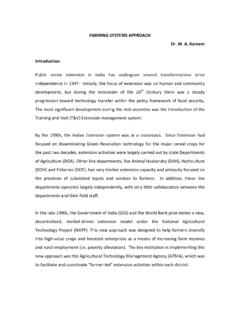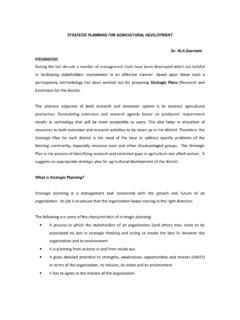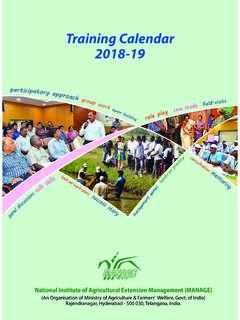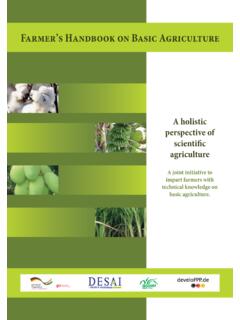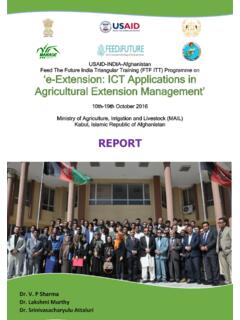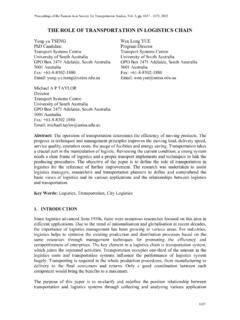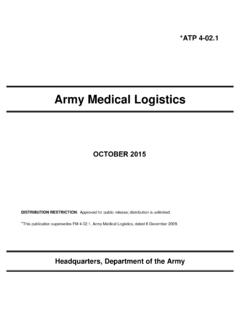Transcription of Geographical Information Systems (GIS) - MANAGE
1 1 Geographical Information Systems (GIS) introduction Geographical Information system (GIS) is a technology that provides the means to collect and use geographic data to assist in the development of Agriculture. A digital map is generally of much greater value than the same map printed on a paper as the digital version can be combined with other sources of data for analyzing Information with a graphical presentation. The GIS software makes it possible to synthesize large amounts of different data, combining different layers of Information to MANAGE and retrieve the data in a more useful manner. GIS provides a powerful means for agricultural scientists to better service to the farmers and farming community in answering their query and helping in a better decision making to implement planning activities for the development of agriculture.
2 Overview of GIS A Geographical Information system (GIS) is a system for capturing, storing, analyzing and managing data and associated attributes, which are spatially referenced to the Earth. The Geographical Information system is also called as a geographic Information system or geospatial Information system . It is an Information system capable of integrating, storing, editing, analyzing, sharing, and displaying geographically referenced Information . In a more generic sense, GIS is a software tool that allows users to create interactive queries, analyze the spatial Information , edit data, maps, and present the results of all these operations.
3 GIS technology is becoming essential tool to combine various maps and remote sensing Information to generate various models, which are used in real time environment. Geographical Information system is the science utilizing the geographic concepts, applications and Systems . Geographical Information system can be used for scientific investigations, resource management, asset management, environmental impact assessment, urban planning , cartography, criminology, history, sales, marketing, and logistics . For example, agricultural planners might use Geographical data to decide on the best locations for a location specific crop planning , by combining data on soils, topography, and rainfall to determine the size and location of biologically suitable areas.
4 The final output could 2include overlays with land ownership, transport, infrastructure, labour availability, and distance to market centers. History of GIS development The idea of portraying different layers of data on a series of base maps, and relating things geographically, has been around much older than computers invention. Thousands years ago, the early man used to draw pictures of the animals they hunted on the walls of caves. These animal drawings are track lines and tallies thought to depict migration routes. While simplistic in comparison to modern technologies, these early records mimic the two-element structure of modern geographic Information Systems , an image associated with attribute Information .
5 Possibly the earliest use of the geographic method, in 1854 John Snow depicted a cholera outbreak in London using points to represent the locations of some individual cases. His study of the distribution of cholera led to the source of the disease, a contaminated water pump within the heart of the cholera outbreak. While the basic elements of topology and theme existed previously in cartography, the John Snow map was unique, using cartographic methods, not only to depict but also to analyze, clusters of geographically dependent phenomena for the first time. The early 20th century saw the development of "photo lithography" where maps were separated into layers.
6 Computer hardware development spurred by nuclear weapon research led to general-purpose computer "mapping" applications by the early 1960s. In the year 1962, the world's first true operational GIS was developed by the federal Department of Forestry and Rural Development in Ottawa, Canada by Dr. Roger Tomlinson. It was called the "Canada Geographic Information system " (CGIS) and was used to store, analyze, and manipulate data collected for the Canada Land Inventory (CLI). It is an initiative to determine the land capability for rural Canada by mapping Information about soils, agriculture, recreation, wildlife, forestry, and land use at a scale of 1:50,000. 3 CGIS was the world's first " system " and was an improvement over "mapping" applications as it provided capabilities for overlay, measurement, and digitizing or scanning.
7 It supported a national coordinate system that spanned the continent, coded lines as "arcs" having a true embedded topology, and it stored the attribute and location specific Information in a separate files. Dr. Tomlinson is known as the "father of GIS," for his use of overlays in promoting the spatial analysis of convergent geographic data. In 1964, Howard T Fisher formed the Laboratory for Computer Graphics and Spatial Analysis at the Harvard Graduate School of Design, where a number of important theoretical concepts in spatial data handling were developed. This lab had major influence on the development of GIS until early 1980s. Many pioneers of newer GIS "grew up" at the Harvard lab and had distributed seminal software code and Systems , such as 'SYMAP', 'GRID', and 'ODYSSEY'.
8 By the early 1980s, M&S Computing (later Intergraph), Environmental Systems Research Institute (ESRI) and CARIS emerged as commercial vendors of GIS software, successfully incorporating many of the CGIS features, combining the first generation approach to separation of spatial and attribute Information with a second generation approach to organizing attribute data into database structures. More functions for user interaction were developed mainly in a graphical way by a user friendly interface (Graphical User Interface), which gave to the user the ability to sort, select, extract, reclassify, reproject and display data on the basis of complex Geographical , topological and statistical criteria.
9 During the same time, the development of a public domain GIS begun by the Army Corp of Engineering Research Laboratory (USA-CERL) in Champaign, Illinois, a branch of the Army Corps of Engineers to meet the need of the United States military for software for land management and environmental planning . In the years 1980s and 1990s industry growth were spurred on by the growing use of GIS on Unix workstations and the personal computers. By the end of the 20th century, the rapid growth in various Systems had been consolidated and standardized on relatively few platforms and users were beginning to export the concept of viewing GIS 4data over the Internet, requiring uniform data format and transfer standards.
10 More recently, there is a growing number of free, open source GIS packages, which run on a range of operating Systems and can be customized to perform specific tasks. As computing power increased and hardware prices slashed down, the GIS became a viable technology for state development planning . It has become a real Management Information system (MIS), and thus able to support decision making processes. Components of GIS GIS enables the user to input, MANAGE , manipulate, analyze, and display geographically referenced data using a computerized system . To perform various operations with GIS, the components of GIS such as software, hardware, data, people and methods are essential.

